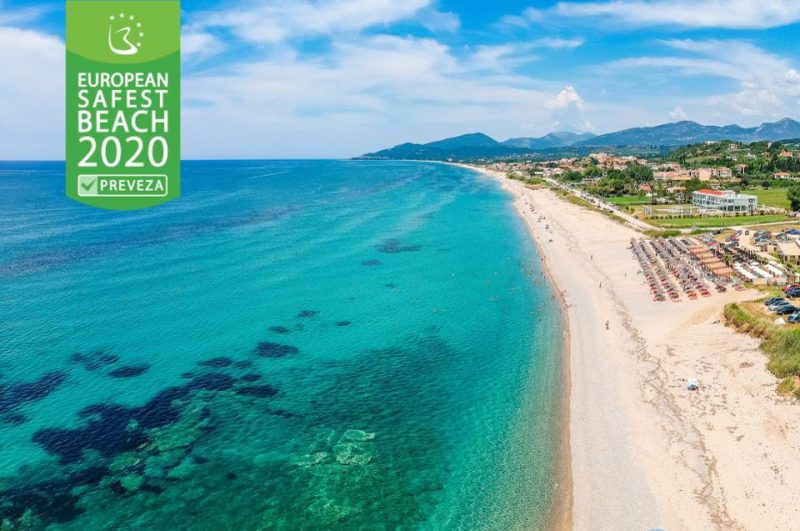#1: Preveza Monolithi beach in Greece, selected the safest beach in Europe EUROPEAN BEST DESTINATIONS
by Cecilia Rodriguez
It’s the biggest question for the summer both inside and outside Europe: to visit or not to visit?
Here are some facts that might help:
- There is urgency to save the travel industry, so vital to the European continent.
- Country by country, governments started easing lockdown measures and will continue moving toward further opening of borders during the coming weeks as the coronavirus gets under control.
- This summer vacation season is expected to be very hot.
- Airlines are gradually reopening flights.
- If the past couple of long weekends are any indication — with parks, beaches and nature reserves filled with people — the summer will most probably see a rush of tourists anxious to get out after months of confinement.
The other question posed by the French magazine Le Point is if “paralyzed by the fear of the virus, struck by confinement, placed on state infusions,” people will still have a taste for freedom? “We are physically emerging from this ‘great confinement,’ but won’t our minds remain under house arrest for a long time?”
Those questions will have some answers when summer comes. In the meantime, and to respond to the need of “space, fresh air, sun but also and above all a safe place,” the European Best Destinations Organization (EBD) which falls under the European Commission’s EDEN Network (“European Destinations of Excellence”) dedicated to promote sustainable tourism in the continent, has selected the safest beaches in Europe post-Covid-19.
The selection is based on various criteria such as low ratio of coronavirus infection, (from 10- to 600-times fewer cases), the size of the beaches and the number of square meters available on the beach per person.
These destinations have also been selected because of their large offer of private villas, tourist apartments, small or medium-sized hotels with specific health charters and commitments to travelers, such as cleaning and room disinfection service after each stay and respect for social distancing.
They’re also located near hospitals that have not suffered overcrowding during the crisis, with an average of hospital beds per inhabitant above the European average.
From Greece and Portugal to Lithuania and Poland, the list include the longest beaches, some of them more than 100 kilometers, where “even at the peak of the season, keeping your distance will not be a problem, for safe holidays.”

Preveza Monolithi beach in Greece, the safest beach in Europe. BEST EUROPEAN DESTINATIONS
# 1: PREVEZA, GREECE
One of the European countries least affected by coronavirus (up to 50 times fewer cases than any other European country), Greece already has taken many safety and health measures into account, shops and restaurants. For example, air conditioner filters are changed after each stay and a distance of four meters is compulsory between each beach umbrella.
“Known for its excellent value for money, Preveza, in the northwestern side of the country at the mouth of the Ambracian Gulf, is called the ‘anti-St. Tropez: hotel, restaurants and café charges are affordable and this summer the deckchairs are free (and cleaned between each traveller). Greece has also cut taxes on flights, trains, buses and many services to attract travelers,” EBD reports.
Monolithi beach, the main beach of Preveza, is 22 kilometers long and up to 80 meters wide. This beach is Europe’s longest.
Hotels and shops of Preveza are reopening starting July 1. No quarantine requested.

Beautiful Alentejo Beach, Portugal. PHOTO: AMERICO LOPES, EUROPEAN BEST DESTINATIONS
#2: COMPORTA, ALENTEJO, PORTUGAL
Sometimes one can stay for hours on this beach and not come across anyone.
Until recently, Madonna would ride her horse here on Sunday mornings and enjoy the tranquility of its 20 kilometers of sandy coast. The Alentejo is one of the regions least affected by coronavirus in Europe (up to 600 times fewer cases than in any other European region.
“Portugal has hundreds of kilometres of magnificent beaches along its coastline, perfect for a family holiday,” EBD concludes. “Comporta beach is just a few kilometres from Lisbon, one of the most beautiful capitals in Europe,”
Comporta offers tourist apartments, private villas and small hotels and Portugal has implemented “Safe and Clean” labels to guarantee accommodation that meets all health measures.
Most hotels will open on June 15, and the rest on July 1. No quarantine requested.

White beautiful beach post coronavirus, Poland. EUROPEAN BEST DESTINATIONS
#3: HEL PENINSULA, POLAND
Together with Portugal and Greece, Poland is among the European countries least affected by coronavirus. There are up to 20 times fewer cases than in the most-affected countries of Western Europe. Here, hospitals have never been overwhelmed and Poland has more hospital beds per resident than many European countries, as in the Netherlands and Switzerland.
“After a flight to Gdansk, one of the most beautiful cities in Europe, take your rental car to ‘Hel Peninsula,’ which despite its name is a paradise on earth,” EBD recommends.
This huge strip of sand is 35 kilometers long and up to 3 kilometers wide. “We recommend you rent a bike to discover all the beauty of this unique peninsula in Europe. If you have time and for the more athletic ones we recommend a four-to-five-day bike trip with stops along the Polish coast.
Where are you going on holiday this summer? ‘I’m going to Hel!’ ”
Polish borders will open to travelers from June 13 without quarantine.

Long beautiful beach post coronavirus, Porto Santo, Portugal. PHOTO: ARMANDO FRAZAO, EUROPEAN BEST DESTINATIONS
#4: PORTO SANTO, MADEIRA ISLANDS, PORTUGAL
Portugal is considered one of the safest destinations this summer: regions including the Azores, the Alentejo and the Algarve have been relatively spared from contagion compared to the rest of Europe. Madeira, in fact, is the least-affected region of Portugal.
“After months of confinement it is a perfect destination to relax in nature. Madeira is an archipelago made up of several islands. There is Madeira, the main island but also other small islands like Porto Santo, (5,500 inhabitants),” writes EBD.
The golden, sandy beaches of Porto Santo are world-famous, in particular for the therapeutic virtues of the sand known as “psammotherapy” (hot sands). Porto Santo spas alternate seawater treatments and warm-sand treatments.
It reopenes to travelers on July 1.

Beautiful long beach post coronavirus, Corfu, Greece. PHOTO: SIMON DANNHAUER, EUROPEAN BEST DESTINATIONS
#5 HALIKOUNAS BEACH, CORFU, GREECE
“Blessed by the gods,” Corfu is one of the greenest Greek islands, with exceptional flora and fauna and Halikounas is one of its largest sandy beaches.
As mentioned above (#1, Preveza Beach), Greece appears as one of the safest destinations in Europe. The government is also taking specific measures for safe vacationing such as social distancing on beaches, room disinfection, air conditioner replacement filters in rooms after each stay, temperature measurement on arrival at the airport, availability of masks and numerous hospital beds. (Greece has more hospital rooms per capita than Ireland or the United Kingdom.)
International flights are planned to restart on July 1. No quarantine requested.

Long beautiful beach post- coronavirus, Malta. EUROPEAN BEST DESTINATIONS
#6: RIVIERA BAY BEACH, MALTA
There have been up to 55 times fewer cases of coronavirus in Malta than in other European countries, an island country with more hospital beds per resident than Finland, Ireland or the United Kingdom — and the epidemic has been very limited in this Southern European island country.
“Dive into the turquoise water of the Mediterranean and discover the treasures and riches of one of the most beautiful destinations in Europe,” EBD advises. “Lay your beach towel on Riviera bay beach or on one of the many other beaches or if you want to distance yourself this summer you can also book your stay in Gozo, a smaller island than the main and ideal for nature lovers, hikers or scuba divers.
Reopening to travelers on July 1.

Long, beautiful beach post coronavirus in Algarve, Portugal. EUROPEAN BEST DESTINATIONS
#7: MEIA PRAIA, LAGOS, ALGARVE, PORTUGAL
As is the case elsewhere in Portugal (see #2 and # 4), the Algarve is one of the regions least affected by coronavirus in Europe — and Lagos is one of the least affected towns in the Algarve.
“Lagos has a very nice historic centre with traditional shops, trendy bars and cafes, a fruit and fish market and magnificent beaches,” explains EBD. “The largest beach in Lagos is “Meia Praia” even if “Meia” means “Medium” in Portuguese,”with five kilometers of golden sand.
Reopening to travelers and the full tourist season, as the rest of Portugal, on July 1. No quarantine requested.

Long sandy beach post coronavirus, Latvia. PHOTO: IKARS, EUROPEAN BEST DESTINATIONS
#8: JURMALA BEACH, LATVIA
Jurmala is a destination labeled “EDEN,” a designation by the European Commission to reward the best sustainable tourism destinations in Europe. The EDEN network now includes more than 90 sustainable tourism destinations.
With 33 kilometers of fine, pure sand, this Latvian region is one of the best sustainable wellness destinations in Europe. “Whether you stay in one of the many art nouveau wooden villas or book your accommodation in a hotel with spa, treatments, massages,” writes EBD, “the sea air and a sweet fragrance of pines floats in the air.”
Latvia has been 60 times less affected by coronavirus than the most-affected European countries and ranks among the European countries with the most available hospital beds per capita.
Reopening to travelers on July 1.

Long white sandy beach post coronavirus in Lithuania / PHOTO: MICHELE URSI, EUROPEAN BEST DESTINATIONS
#9: NIDA BEACH, NIDA, LITHUANIA
A unique place in Europe, ideal to disconnect from social networks yet offering continuous news channels and reconnection with nature, Nida is located one hour by car from Klaipéda and four hours from Lithuania’s capital, Vilnius.
“More than 100 kilometers of fine sand await you in this paradisiac place, almost cut from the rest of the world,” explains EBD.
“The sea, the dunes, the forest and you: your program for your next holiday.”
Greatly appreciated by Lithuanian and German travelers, this beach on the Isthmus of Curlandia, “smells of pine mixed with the sweet iodized scent of the sea. You can rent bikes on site: There’s a large cycle path running almost along the isthmus or do water sports (kitsurfing, windsurfing). Do not miss climbing up to the dune of Parnidis, the second highest dune in Europe (second after the dune of Pyla located in Aquitaine/France).”
With 40 times fewer cases of coronavirus than the most-affected European countries, Lithuania is in the high average of the number of hospital beds per inhabitant. (Only Germany and Austria do better in Europe).
The tourist season should restart on July 1.

Sandy beach post coronavirus in Ruigen Island, Germany / PHOTO: PAWEL-KAZMIERCZAK, EUROPEAN BEST DESTINATIONS
#10: BINZ BEACH, BINZ, RÜGEN ISLAND, GERMANY
This 5 kilometer-long sandy beach is considered one of the most beautiful and longest along Germany’s Baltic coast.
Germany was 10 times less affected by the coronavirus than some European countries and Mecklenburg-Western Pomerania was particularly spared with 80 times fewer cases than in the countries most affected.
“Rügen Island is a perfect destination for nature lovers and Binz is one of its best known resorts, but you can book in Sellin or Göhren or anywhere else on the island,” writes EBD.
Germany will open its borders from June 15 but the tourist season with international flights should restart from July 1. No quarantine requested.




